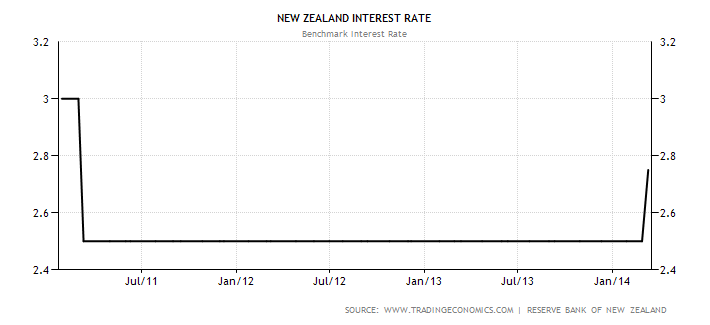The strong New Zealand economy has seen the country’s central bank lift interest rates this morning by a quarter of a per cent to 2.75%, the first movement in rates for three years. And the bank left markets in no doubt that more rate rises are in the offing.
Citing the strength of the economy, especially exports and building activity, the Reserve Bank of New Zealand said the rate rise was "needed to keep future average inflation near the 2 percent target mid-point….to ensure that the economic expansion can be sustained."
The move was not unexpected and has been forecast for the past six weeks, since the last meeting of the RBNZ when the bank revealed its growing concern about inflation and the strong growth in the economy.
The Kiwi dollar rose after the topping the 85 US cent mark from 84.65 cents just before the statement (and not far from parity with the Aussie).
It came the same day as the Thai central bank cut rates to 2% to try and stave off a looming slump caused by the continuing political problems. South Korea’s central bank meets later today and is expected to leave rates alone.
India, Russia, Turkey and Brazil have all lifted interest rates in the past six weeks to defend weakening currencies, not to try and slow a strongly growing economy, as we saw in New Zealand this morning.
NZ lifts OCR to 2.75% in first movement for three years

NZ’s move will not make much of a difference to the economy, so those Australian companies – especially the big four banks and retailers such as Woolworths, will continue to do well, perhaps better than they are doing currently in their home market.
In the statement this morning the RBNZ said "New Zealand’s economic expansion has considerable momentum, and growth is becoming more broad-based. GDP is estimated to have grown by 3.3 percent in the year to March. Growth is gradually increasing in New Zealand’s trading partners.
"However, improvements in major economies have required exceptional support from monetary policy. Global financial conditions continue to be very accommodating, with bond yields in most advanced countries low and equity markets performing strongly.
"Prices for New Zealand’s export commodities remain very high, and especially for dairy. Domestically, the extended period of low interest rates and continued strong growth in construction sector activity have supported recovery.
"A rapid increase in net immigration over the past 18 months has also boosted housing and consumer demand. Confidence is very high among consumers and businesses, and hiring and investment intentions continue to increase.
"Growth in demand has been absorbing spare capacity, and inflationary pressures are becoming apparent, especially in the non-tradables sector. In the tradables sector, weak import price inflation and the high exchange rate have held down inflation. The high exchange rate remains a headwind to the tradables sector. The Bank does not believe the current level of the exchange rate is sustainable in the long run.
"There has been some moderation in the housing market. Restrictions on high loan-to-value ratio mortgage lending are starting to ease pressure, and rising interest rates will have a further moderating influence. However, the increase in net immigration flows will remain an offsetting influence.
"While headline inflation has been moderate, inflationary pressures are increasing and are expected to continue doing so over the next two years. In this environment it is important that inflation expectations remain contained.
"To achieve this it is necessary to raise interest rates towards a level at which they are no longer adding to demand. The Bank is commencing this adjustment today. The speed and extent to which the OCR will be raised will depend on economic data and our continuing assessment of emerging inflationary pressures," the RBNZ said.













